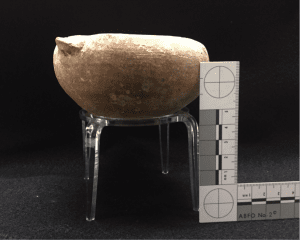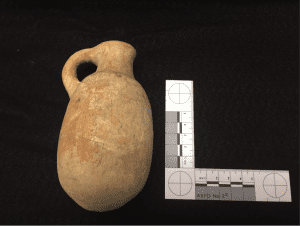What is the Utility of Biblical Archaeology?
What is the Utility of Biblical Archaeology?
Guest Post by Don McNeeley
Please allow me to introduce you to a dear friend from Tony’s and my Virginia Beach days, Don McNeeley. If you remember from July’s “3” Newsletter–where we connect on three interesting, personal, and/or helpful topics each month–my family and I visited with friends back east this summer. That visit included a Biblical archaeologist and his beautiful wife. That archaeologist was Don. The story of David, lamp sizes of the time, and Psalm 119 danced to life in a whole new way with Don’s words and archeological finds. Today, we have the privilege of digging into Biblical archaeology to help illuminate Scripture right here on KristiWoods.net. So take a seat, prop up your feet, let Don do the shoveling, and soak up the insight and potential found with these archaeological digs.
Biblical archaeology has the unique capability of connecting the biblical text with cultural remains from the times of the scripture. These cultural remains assist in illuminating the scripture and can at times even provide interpretative understandings that would be missed by the casual reader. As a biblical archaeologist, I am constantly looking into the sands of time to obtain information that will help me understand scripture. For this article, I want to describe two archaeological artifacts that have expanded my understanding of interesting sections of scripture.
Joshua 5:24-26 – A Small Bowl
The picture here is an Iron I age bowl from Israel. It is a finely made bowl and lacks evidence of much service. In many ways, it could be considered to reflect a piece of “china” from the Iron I period. The Iron I age is associated with much of the book of Judges and it is in Judges 5:24-26 that I can see an example of how archaeology assists in understanding scripture.
The situation in Judges 5:24-26 is that King Sisera is fleeing for his life from the army of the Israelites. He comes upon a desert tent and seeks shelter. It seems that Sisera is comfortable with resting in this tent, maybe because he thought he would be protected. The question that seems to beg itself is why did Sisera feel safe enough that he would easily go to sleep, knowing that the Israelites were on his trail?
The mention that the bowl is a noble’s bowl and what that bowl may have looked like are clues to the answer.
The daintiness of the bowl reminds me of dinners when the china comes out of the cabinet where it has resided since the last special meal. It is extremely thin and has a graceful curve to it. Just like your use of “china” for those special meals, the scripture states that this bowl was a “noble’s bowl” used to serve special people.
Judges 5:24-26 implies that Sisera was received as a special guest. Just like during special meals today where the food is served on “china”, the milk for Sisera was served in the “china” of the day. The use of the “china” symbolically conveyed to Sisera that he was being honored and therefore he felt safe and secure. With that knowledge, he fell asleep thinking he had nothing to fear, but alas the story concludes with Jael killing Sisera with a tent peg into his head. So, why Sisera let down his guard is explained by his being served milk in a noble’s bowl.
1 Samuel 10:1 – Small Jug
In 1 Samuel 10:1, we have another example where archaeology sheds light on the scripture, allowing a deeper understanding of the verse. In the verse, it states that “Samuel took a flask (small jug) of oil and poured it on his head (King Saul) and kissed him and said, ‘Has not the Lord anointed you to be prince over his people Israel?’ (English Standard Bible)”
The Hebrew word used in this scripture to indicate the word flask is for a small jug. So, while we may think of a flask being used, in reality it was a small jar.
Again 1 Samuel 10:1 is situated in the Iron I period and the picture here is of a small jug from that period and represents the one Samuel used. This small jug is about six inches tall and three wide at its largest diameter. It is a really small jug and would not have held much oil. Additionally, the small jug is made out of clay, so if dropped it would have easily shattered.
Using this information from the scripture combined with the archaeological data, it is possible through the use of a small fragile jar of oil, Samuel is foretelling the length and frailty of Saul’s reign.
Biblically, oil frequently refers to the Holy Spirit. Such a small jar would not have held much oil. Samuel might have been using the small jar to indicate how long the Holy Spirit was going to cover Saul as he reigned. Additionally, the frailty of the jar might have been used to indicate the fragile nature of Saul’s regime over Israel. While some of this understanding comes about through a knowledge of Hebrew, the archaeological evidence of a small jug brings life to the verse and its political prophecy.
I hope these two examples of understanding the archaeological artifacts illuminate the biblical record. If you desire to receive a newsletter in which I discuss biblical archaeology, please send your email address to [email protected]. I will place you on my newsletter.
About Don ~

Don McNeeley has excavated at two biblical sites in Israel (Shiloh and Maqatir) over the past eight years and traveled throughout Israel many times. His passion is to understand the archaeological data and how that data illuminates our understanding of scripture, spiritual formation, and even worship. Don uses the knowledge gained from the trips to Israel in his teaching biblical studies at Tidewater Bible College in Virginia Beach, VA.
Jug and bowl photos by Don McNeeley. Used with permission.
Linking with other Jesus lovers here: #heartencouragementThursday, #faithonfire.









Simply fascinating … the biblical stories come to life!
Sitting with Don and his wife this summer WAS fascinating, Linda. He brought PS 119’s conversation about lamps and their size into a whole new light–no pun intended. 😀 The oil lamps of the time were small, offering just enough light for one or two steps ahead. Now, that’s faith.
One of the main reasons I have determined to study archaeology is exactly the light that is gained by understanding the artifacts dug from the sands of time.
Fascinating article, Don. One of my favorite Christian television shows is BibleDiscoveryTV/QuickStudy. They go through the entire Bible each year. Their daughter is an archeology journalist. The images she shows from findings in Israel are fascinating. They make the verses of scripture jump off the page and help to make a little more sense. Thank you or sharing your insights. Have a wonderful week. God bless you and yours.
An insight that jumps off the pages of scripture is the size of the stone David used in his battle with Goliath. Most folks think it was a small pebble, but more than likely, it was the size of a pool ball. When it hit Goliath, he definitely knew he was hit and more than likely, he was dead before he hit the ground!
Love how the archaeological details bring those stories to life, bringing a clearer understanding to the pages of Scripture. Thanks, Don, for the insights and, Kristi, for sharing his words with us.
It’s my pleasure, Crystal. These details certainly do bring the Bible to life.
So, if you want an opportunity to see the sites up close and personal, I am assisting on leading a two week tour of Israel with a one day trip into Jordan. Contact me at [email protected] if you might be interested and I will send the information.
very good, I found this site and I am happy to have this knowledge.
Fascinating! Loved the history and context you gave through this. ❤️???? Thank you for sharing your knowledge with us.